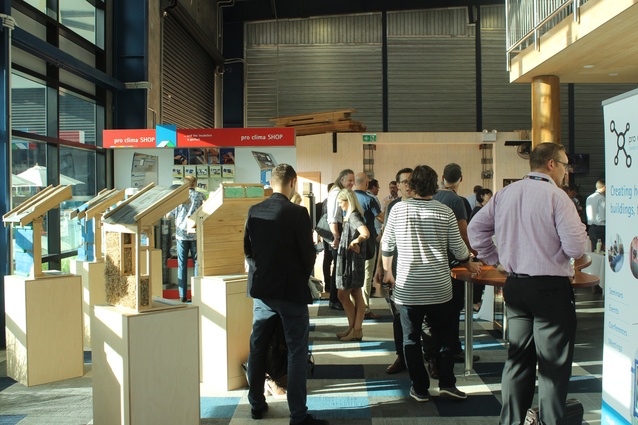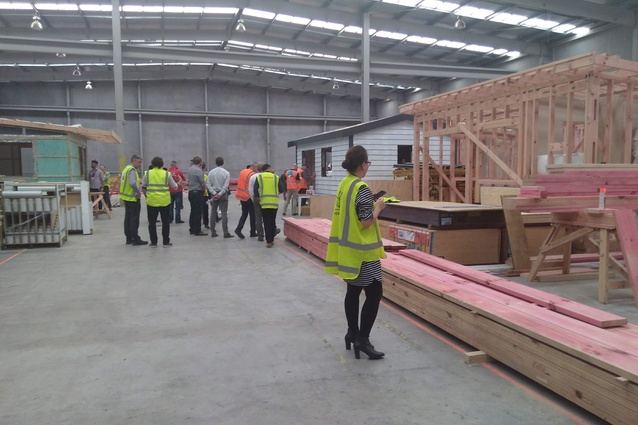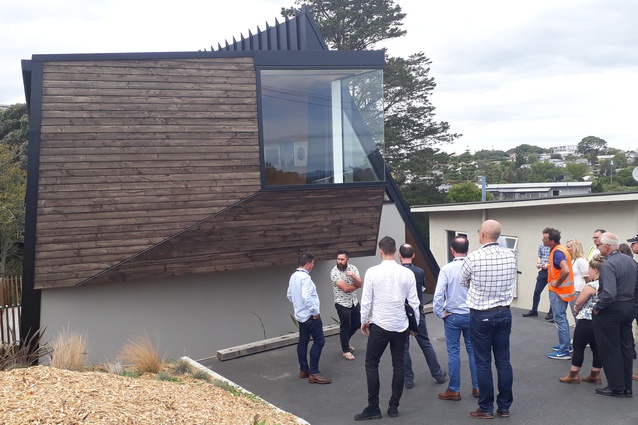Review: CoLab 2019
Architects Patrick Loo and Claire Natusch reflect on the 2019 iteration of PrefabNZ's event of the season.
Many would argue that New Zealand is in dire need of alternative building delivery models. Conventional methods are struggling to meet demand. For the past eight years, PrefabNZ, the self-proclaimed “heart of innovative construction in New Zealand”, has been championing offsite building design and construction models this country should be embracing. Their enthusiasm and optimism are most evident at PrefabNZ’s annual event, CoLab, a conference looking to provide discourse, provocation and solutions to challenge the status quo within New Zealand’s construction industry.
CoLab 2019 was recently held in Auckland over three days, with a combination of site visits, speaker presentations and round table discussions. We liked that the event takes a multi-faceted and multi-disciplinary approach towards discussing the value, potential and challenges facing offsite manufacturing. Many perspectives were presented relating to regulatory frameworks: central and local government vision, manufacturing drivers, financial tools, design approaches and greater social and economic factors affecting the industry.
Any conversation regarding construction initiatives within New Zealand will touch upon housing supply and affordability and, sure enough, it was the front and central theme driving the majority of discussions. Predictably, the government’s KiwiBuild programme was also a hot topic. Phil Twyford, minister for housing and urban development, began proceedings on day two by reaffirming the government’s commitment to the offsite manufacturing industry and its “mission-critical” role to delivering the KiwiBuild programme.
In response to critics of Kiwibuild’s ambitious targets, Twyford stated that as a “government of change”, they will be required to take some risks to deliver that change. However, for those in the audience supposedly being called upon to help bring about this change, their key concern was how KiwiBuild’s contractor procurement process would allow offsite manufacturing to grow and survive in the long-term.
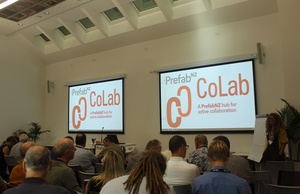
The offsite industry is still a precarious business, as evidenced by the recent collapses of Matrix Homes, eHomes and ABT. This had been raised in a confrontational manner at CoLab 2018, and the government was now well aware that the industry was not going to invest in production facilities without guarantees of a secure pipeline of work. Twyford stated that 44 firms had now been shortlisted for contracts to supply offsite manufacturing solutions at scale for KiwiBuild.
Similarly, Housing New Zealand (HNZ) also felt the need to reassure the audience as Patrick Dougherty, general manager for Asset Development, outlined their change in procurement approach to achieve long-term stability for delivery partners. This has resulted in HNZ now purchasing offsite manufacturers’ production capacity, rather than engaging on a project-by-project basis. This could result in a reduction of margin that typically exists to cover pipeline risk and order shortfall. As the country’s largest landlord, with 64,000 properties, the enormous task facing HNZ was apparent when Dougherty stated that 80 per cent of this building stock will need intervention or replacement over the next 20 years.
In an effort to help support the increased involvement of offsite manufacturing within the construction sector, both Jenny Salesa, minister for building and construction, and Ian McCormick, manager for building control at Auckland Council, outlined changes within the regulatory and consenting frameworks to foster “innovative and modern methods of construction”. Initiatives such as a “one dwelling, one consent” approach and national multi-use approvals were being set up to facilitate easier consenting for offsite manufactured buildings.
However, it wasn’t all good news, as their comments about upcoming reviews regarding risk and liability settings for buildings seemed to warn of sweeping changes about to come. Their veiled comment that risk responsibility should sit with the party best able to manage it indicates that industry players need to be on alert.
Housing New Zealand’s commitment to prefabrication was in evidence at the first site visit to a 66-unit development in Mangere. The three-levelled buildings, with prefabricated timber structure and exterior panels, were delivered by Tallwood, the product of a merger between Stanley Modular (the offsite manufacturing division of Stanley Group) and tech start-up Tallwood. Work started on site in Mangere in October and is aiming to be completed by June.
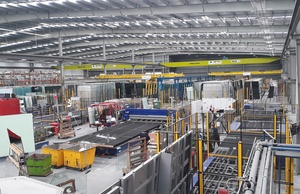
Tallwood had a big presence at CoLab 2019, where they also announced their new, patent-pending construction system called Bohrhouse, which they had developed with Brookfield Scientific Solutions (BSS). The system was unveiled to us on the second day by the delightfully crass Professor James Murray-Parkes, director of BSS, who leads a team of mathematical and scientific whiz-kids – the brains behind a string of innovations in structural design, many of which have been utilised principally for Multiplex megastructures.
After watching a heavily loaded truck ricochet off a roadside guardrail, Murray-Parkes was inspired to create the Bohrhouse structure. Looking at the relatively unscathed guardrail, Murray-Parkes realised that the composite steel and timber design was “tough as shit”, so he started looking at how to utilise its strength in construction.
Brookfield Asset Management, who own BSS, is one of those incomprehensively large companies that have a finger in every pie. Fortunately for Murray-Parkes, it turned out they also own Armco, a large manufacturer of roadside guardrails. It will be interesting to see how much uptake the system gets in New Zealand.
Innovation was certainly at the heart of Lucy Black’s presentation. As head of business relationships at the Construction Scotland Innovation Centre (CS-IC), Black helps coordinate much between industry, government, academia and the public sector. CS-IC’s role is one of facilitation: developing strong commercialisation strategies or partnering private companies with one of their 14 partner universities to carry out research and development. This definitely caught the interest of many local academics in the audience, who were keen to know how CS-IC’s model worked.
CS-IC also offers funding for industry or public sector-led projects, along with access to a dedicated workshop facility with tools for prototyping and testing. We thought it was a particularly promising way of supporting innovation that has a social or environmental benefit. Black shared examples, such as the K-briq, a brick made from 90 per cent recycled building material, and their support for the delivery of the tallest Cross Laminated Timber (CLT) building in Scotland, as a means of testing CLT’s commercial viability.
Scotland shares New Zealand’s penchant for timber; it is the major material in their prefabrication industry. In fact, CoLab 2019 could have been suitably subtitled the ‘NZ timber offsite construction conference’. Concrete seemed like a dirty word and no one breathed a word of steel.
NZWood is getting in on the promotion of offsite technologies, with a free design guide – Designing for Prefabrication – set to be released this month. PrefabNZ had their own design guide launched at CoLab, with a focus on case studies, including the recently announced SNUG competition winners.
The brief of SNUG was for a complementary backyard dwelling of less than 65m2, to meet the Auckland Council’s definition of a minor dwelling. There were digitally-cut models on display at the conference showing some fairly predictable approaches but, also, imaginative offerings, such as Flip house, a structure that can literally be turned on its side, and the Porch house, designed for a sloping site. PrefabNZ had marketing material on the winning entries with a step-by-step guide for those interested in having their own SNUG home.
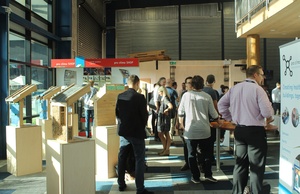
A major restriction for those interested in going down the prefabricated path has been the inability for borrowers to get a mortgage whilst their house is in the factory. The standard lending procedure of releasing payments periodically as a house goes up on site has historically relied on material to secure against.
With offsite construction, materials don’t reach site until the building is almost complete, so contractors have had to take the risk that an owner will get finance upon completion. This had been raised as a major hurdle at last year’s CoLab, so it was pleasing to see Westpac and Builtin unveil new mortgage and insurance products respectively for prefabricated housing construction.
Digital technology has the potential to offer a level of customisation that makes offsite construction relevant to most bespoke designs. As architects, we were glad to see this addressed (albeit too briefly) at the conference, particularly by Australian architect Craig Chatman of ARKit, a prefabricated design-build group based in Melbourne. His projects are a far cry from flimsy portacoms. A notable example was the result of his collaboration with John Wardle Architects. Limestone house required a high-performance design to meet Passivhaus and Living Building Challenge requirements – prefabrication helped them to achieve this and to greatly reduce build time on site.
Replication wasn’t on Craig Wilson’s mind either when he embarked on building a house for his young family in Grey Lynn. The site visit to the 132m2 house was a delightful way to round out the first day of CoLab, which was otherwise filled with stops along the various stages of the prefab production line. Designed by Wilson and Nicholas Dalton of TOA Architects, they saw the project as an opportunity to experiment. The floors, roof and most of the walls are CLT and it only took 10 days on site to construct the house envelope, from its foundations up.
The playful design has pushed the materials outside the usual prefab box by tilting walls, cantilevering floors and punching out around windows. For some attendees on the tour, the unlined CLT structure resulted in an overwhelming exposure to yellowy pine. A few murmured that they felt they were in a sauna, however, we thought the timber was thoughtfully used and TOA architects did a good job of minimising the Lockwood house look of pine by using dark cabinetry and exposed concrete surfaces. Despite all the CLT, the prefab buffs on the bus seemed more taken with the beautiful cast-in pattern on the concrete wall surfaces, created by grinding back the imprint left by the polystyrene formwork.

As with any good conference, there were evening drinks, an opportunity to mix and mingle and toast the wonderful Pamela Bell, who is stepping down as CEO of PrefabNZ. Arguably, CoLab wouldn’t exist if it wasn’t for Bell, who organised the first industry event back in 2010 as part of her masters thesis. Chris Moller gave a touching tribute on behalf of the PrefabNZ board members, describing the stresses and trials that Bell has calmly guided the non-profit organisation through over the last eight years.
Bell is certainly held in very high regard by the entire offsite industry and will be a hard act to follow. By bringing together all the elements involved along the supply chain – from government to design manufacturing to finance – PrefabNZ, under Bell’s tenure, has rightfully taken a holistic approach towards solution-forming. Writing as two architects, we often wish that our own institute would take a more inclusive approach when discussing architectural issues requiring a collaborative nature.
CoLab 2019 demonstrated that the parties around PrefabNZ are definitely maturing, with government bodies such as HNZ and KiwiBuild paying careful attention to the offsite construction opportunities PrefabNZ champions. The question seems to be, will this attention result in enough support to create an industry that those at CoLab are hoping for? Or, will there be further speed bumps before stability is reached?
Innovation and action are often the result of getting the right people in the room together and CoLab 2019 was absolutely about fostering these opportunities.

